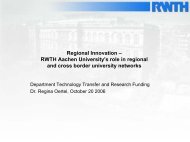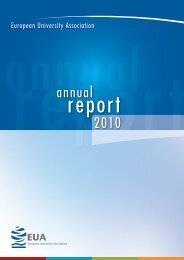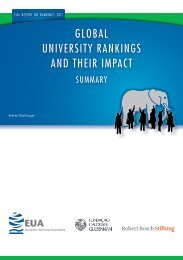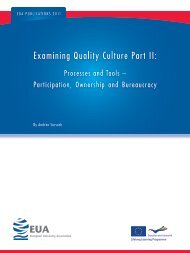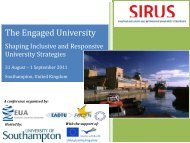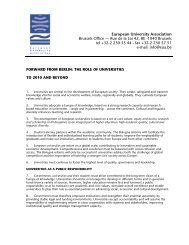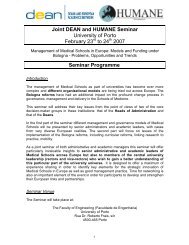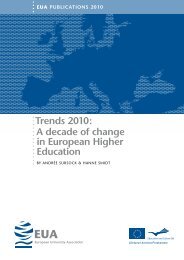Beiträge zur Hochschulforschung - European University Association
Beiträge zur Hochschulforschung - European University Association
Beiträge zur Hochschulforschung - European University Association
You also want an ePaper? Increase the reach of your titles
YUMPU automatically turns print PDFs into web optimized ePapers that Google loves.
28<br />
Thomas Estermann, Enora Bennetot Pruvot<br />
ties’ financial sustainability. Such increases in student numbers may also affect the<br />
universities’ different activities, if these increases are not reflected in correspondingly<br />
higher budgets.<br />
In many countries, governments have discarded previous commitments to increase<br />
funding. Both communities in Belgium have also reported that their regional govern-<br />
ments have abandoned previous plans to increase funding. In the Flemish community<br />
of Belgium, universities are coping with a three-year funding freeze which has replaced<br />
a previously promised increase of approximately 10 per cent; while the French speak-<br />
ing community has seen the planned 8 year investment of 30 million Euro now ex-<br />
tended over 15 years. Similarly, in Austria, plans by the government to increase<br />
higher education expenditure by 2 per cent between 2013 and 2015 have now been<br />
scrapped, as negotiations have clearly shown that a budget cut will be inevitable for<br />
this same period.<br />
In contrast, some <strong>European</strong> governments have upheld their commitments, or indeed<br />
provided new investments to fund higher education, like in Norway.<br />
France’s announcement of the “Grand Emprunt” (national loan) has seen a significant<br />
increase in overall higher education funding, which comes as part of a large investment<br />
in key priority areas, especially teaching and research. In 2010, 11 billion Euro were<br />
foreseen for investments to improve the overall quality of higher education and 8 billion<br />
Euro invested towards developing research. A further 8 billion Euro had been foreseen<br />
to create new university campuses of excellence or go towards restructuring existing<br />
ones. The prospect for 2011 remains positive, as a further increase of the budget by<br />
about 4,7 billion Euro, mainly to raise the attractiveness of career personnel, to support<br />
university reform, student social policy and increased resources for research, has been<br />
foreseen. However, since a major part of the investments foreseen by the “Grand<br />
Emprunt” consist of capital contributions, this means that the actual amount received<br />
by universities ultimately depends on the financial markets and is likely significantly<br />
smaller.<br />
Another case where funds for higher education have been raised over recent years is<br />
Germany. Though higher education funding in Germany is largely provided by Länder<br />
authorities, the federal government has been increasing investments to support the<br />
financial security of German higher education and research institutions. The invest-<br />
ments will provide an additional 800 million Euro under the renewed Higher Education<br />
Pact which will support growing student numbers until 2015. The federal government<br />
will also invest a further 2,7 billion Euro from 2012 – 2015 through the German Excel-<br />
lence Initiative, as well as provide additional funding through the 5 per cent per year<br />
increase for the Innovation and Research Pact until 2015. Federal authorities with state<br />
<strong>Beiträge</strong> <strong>zur</strong> <strong>Hochschulforschung</strong>, 33. Jahrgang, 2/2011



